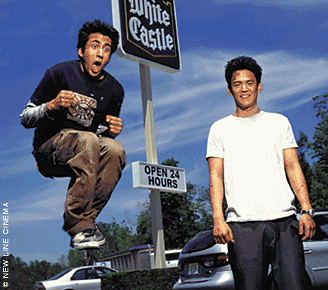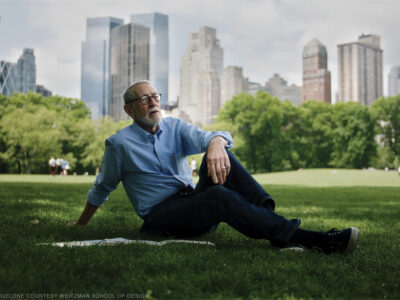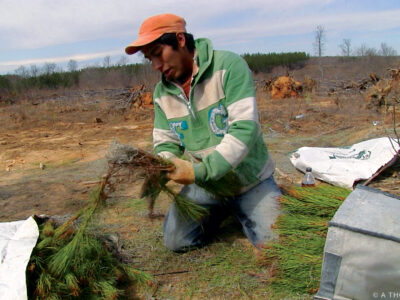
There has always been a creative mistress leading Jon Hurwitz W’00 astray. It’s an alluring thing called comedic screenwriting, and it has taken him a long way from the Wharton School and his goal of becoming an investment banker.
Hurwitz’s high-school pal, Hayden Schlossberg, had a similar infatuation. But both of them were realistic enough to know that a screenwriting career would have to wait until they had made some money working “real” jobs. In the meantime, they continued to develop ideas together. And when Hurwitz saw a book for sale one day during his sophomore year—one remarkably similar to an idea he and Schlossberg had developed in high school—he decided their pursuit of a writing career couldn’t wait.
He called Schlossberg, who attended the University of Chicago, and told him to move to Philadelphia that summer and live in his off-campus house at 4007 Baltimore Avenue so they could write. They got “responsible” day jobs, and at night they wrote a 250-page version of their first screenplay, Filthy—initially called Outside the Box—about two best friends trying to figure out what to do after college. It was, by their account, good material formatted badly.
During Hurwitz’s junior year they began to get the hang of the art form, and trimmed 140 pages from the manuscript. By the spring of 2000, they sold Filthy, graduated, and moved to Hollywood.
Four years later, they’ve found commercial success and critical recognition as the writers of Harold & Kumar Go to White Castle, which A.O. Scott of the The New York Times described as “one of the few recent comedies that persuasively, and intelligently, engage the social realities of contemporary multicultural America.”
Hurwitz spoke with Gazette freelancer Kent Malmros C’00 about his journey as a screenwriter, and Harold & Kumar.
Did you know while you were writing the script for Harold & Kumar that it had the potential to become a mainstream studio film?
When you write a stoner comedy with Asian and Indian lead characters, you should know that no studio in town would ever consider buying or making it. If they do buy the script, you figure they’ll have you change it to a couple of white guys, or a white guy and a black guy. We never wanted to do that, but at the time it was the project we felt the most passionate about. So we decided to write the movie.
What was the inspiration for the lead characters?
Hayden and I started writing movies because we felt we could write funnier and more realistic characters than those we were currently seeing in youth comedies. Since we had a lot of Asian and Indian friends, we always included a lot of Asian and Indian characters in our movies.
One day, we just said, “What if, instead of making the Asian-American characters in our script side-characters, what if we made them the main attraction?” Since Hayden and I always try to say a little something in our movies, we felt that this sort of unique set-up would allow us to write a movie that examines the racial climate of America, while still keeping the ridiculous and irreverent tone of a youth comedy. Plus, we liked the idea of writing something that was unique. Usually, the Asian guy is either doing martial arts or answering a scientific question, but in our movie we were delving deeper into the lives of these characters.
It must have been particularly difficult to balance the accurate portrayal of certain races with the drug counterculture.
Exactly. We’re showing these two guys as stoners immediately in the movie. But what we’ve always said is that this isn’t a movie about the Asian-American experience, or a movie about what all Indian people are like. This is a movie about two characters, Harold and Kumar, and what they’re like. They happen to be Asian and Indian. And they happen to be two very real guys. Guys that are intelligent—one of them is about to go to med school; one of them is an investment banker. Yet they still smoke weed.
The movie takes place exclusively in New Jersey—including a pivotal scene at Princeton. As a Penn graduate, how did you let that happen?
We wanted to make a movie that would be a Jersey road-trip movie. We didn’t want to complicate things by having them go to New York or Philadelphia, and go over state lines. We felt it was very clean to keep it all in New Jersey. That’s why they ended up going to Princeton.
But it does add an interesting dynamic to the movie that you chose an Ivy League university. It was important to what you were trying to accomplish with this movie.
Absolutely. We were trying to establish that these were educated people, who hang out with educated people.
In an ideal world I would have liked to use Penn if it was an Ivy League School in New Jersey. We used Princeton because it actually is an Ivy League school in New Jersey.
So we certainly weren’t running from writing a Penn movie. In fact, we wrote an early script based at Penn, and hope to write movies that take place at Penn in the future.
At what point did you stand back and realize you had made it in Hollywood? Was it with the sale of this script?
It was the collective experience of filming Harold & Kumar. I had never really been on a movie set—so the first time I was on a movie set was to film a movie Hayden and I wrote. And we were fans of a lot of the cast in the movie. For years, we talked about these actors, and all of a sudden we found ourselves in Toronto with these people, spending hours just shooting the shit with these guys, or partying at night. Or we’d watch them act out our scenes and help them with their lines. For us that was the most surreal experience.
What’s next for you?
We are currently working on several projects, including The Gym Teacher and The Wingman—a big, commercial idea based on the bar scene. We’re also rewriting a parody of the Lord of the Rings and Harry Potter movies.
On top of that, we’re very interested in moving into directing. We learned a ton from [Harold & Kumardirector] Danny Leiner. And we’d love to be able to complete our own vision from start to finish on a movie. We’ve had a number of studios approach us about directing already. So we’re very hopeful of directing something over the next couple of years.
Through our experiences we’ve moved into producing as well— including two projects with Josh Heald W’00, one of my best friends from Penn.
The end of Harold & Kumar suggests a sequel—a journey in Europe. You didn’t mention that, so is that project in development?
We have a deal in place to write the sequel, and have already been sent to Europe on a research trip. And most of the sequel has already been planned. However, we’re waiting to see how the movie does on DVD before going through with it. The movie has been profitable, but not big enough yet to warrant a sequel. It’ll take a certain amount of money through DVD sales for that project to get greenlit. We expect that to happen, but we’ll see.




